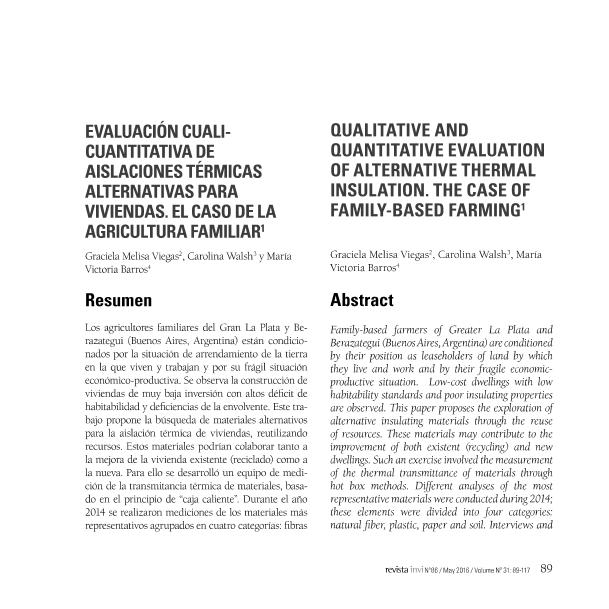Artículo
Los agricultores familiares del Gran La Plata y Berazategui (Buenos Aires, Argentina) están condicionados por la situación de arrendamiento de la tierra en la que viven y trabajan y por su frágil situación económico-productiva. Se observa la construcción de viviendas de muy baja inversión con altos déficit de habitabilidad y deficiencias de la envolvente. Este trabajo propone la búsqueda de materiales alternativos para la aislación térmica de viviendas reutilizando recursos. Estos materiales podrían colaborar tanto a la mejora de la vivienda existente (reciclado) como a la nueva. Para ello se desarrolló un equipo de medición de la transmitancia térmica de materiales basado en el principio de ?caja caliente?. Durante el año 2014 se realizaron mediciones de los materiales más representativos agrupados en cuatro categorías: fibras naturales, plásticos, papel y tierra. Las mediciones cuantitativas fueron contrastadas con la opinión de los posibles usuarios de estos materiales y la de técnicos que trabajan con este sector social, a través de entrevistas y consultas. Los resultados mostraron que el cartón corrugado y el polietileno reciclado tienen buena respuesta térmica, costo bajo o nulo, reducen un desecho existente y los usuarios consideran posible su aplicación si se resuelven problemas de estanqueidad, humedad y condensación. The amphibolite facies (high temperature/ low pressure; HT/LP) migmatites from Sierra de Molinos, Eastern Cordillera, offer an excellent opportunity to evaluate the trace element distribution and the degree of partial melting throughout anatexis, because they preserve much of the structures indicative of an almost perfect separation between melt and solid residuum. The key samples were taken from leucosomes and melanosomes from metatexites (Sil–Kfs zone) with a rock core drill machine. Leucosomes were sampled from dilatant sites within a stromatic metatexite, whereas the melanosomes were taken from the boudinaged matrix. This enables getting the maximum separation between the materials that represents pure melt (leucosomes) and the residuum left after melt extraction (melanosomes). Major and trace element concentrations were acquired from a metapelite from the Puncoviscana Formation, assumed as the protolith, the leucosome–melanosome pairs, metatexites and diatexites migmatites. The degree of partial melting was calculated by simple mass balance, using the major and trace element composition of leucosome-melanosome pairs, obtaining a result of 17 to 23 wt%. The assessment of trace element distribution allowed to understand the complexity of processes implicated in the evolution and diversification of anatectic magmas which occurred close to the source. Because of this, these processes must be taken into account when modelling partial melting processes using composition of granitic rocks emplaced in crustal levels far from the source.
Evaluación cuali-cuantitativa de aislaciones térmicas alternativas para viviendas. El caso de la agricultura familiar
Título:
Qualitative and quantitative evaluation of alternative termal insulation. The case of family-based farming
Fecha de publicación:
05/2016
Editorial:
Universidad de Chile. Facultad de Arquitectura y Urbanismo. Instituto de la Vivienda
Revista:
Revista INVI
ISSN:
0718-8358
Idioma:
Español
Tipo de recurso:
Artículo publicado
Clasificación temática:
Resumen
Archivos asociados
Licencia
Identificadores
Colecciones
Articulos(CCT - SALTA-JUJUY)
Articulos de CTRO.CIENTIFICO TECNOL.CONICET - SALTA-JUJUY
Articulos de CTRO.CIENTIFICO TECNOL.CONICET - SALTA-JUJUY
Citación
Viegas, Graciela Melisa; Walsh, Carolina; Barros, Maria Victoria; Evaluación cuali-cuantitativa de aislaciones térmicas alternativas para viviendas. El caso de la agricultura familiar; Universidad de Chile. Facultad de Arquitectura y Urbanismo. Instituto de la Vivienda; Revista INVI; 30; 86; 5-2016; 87-115
Compartir




